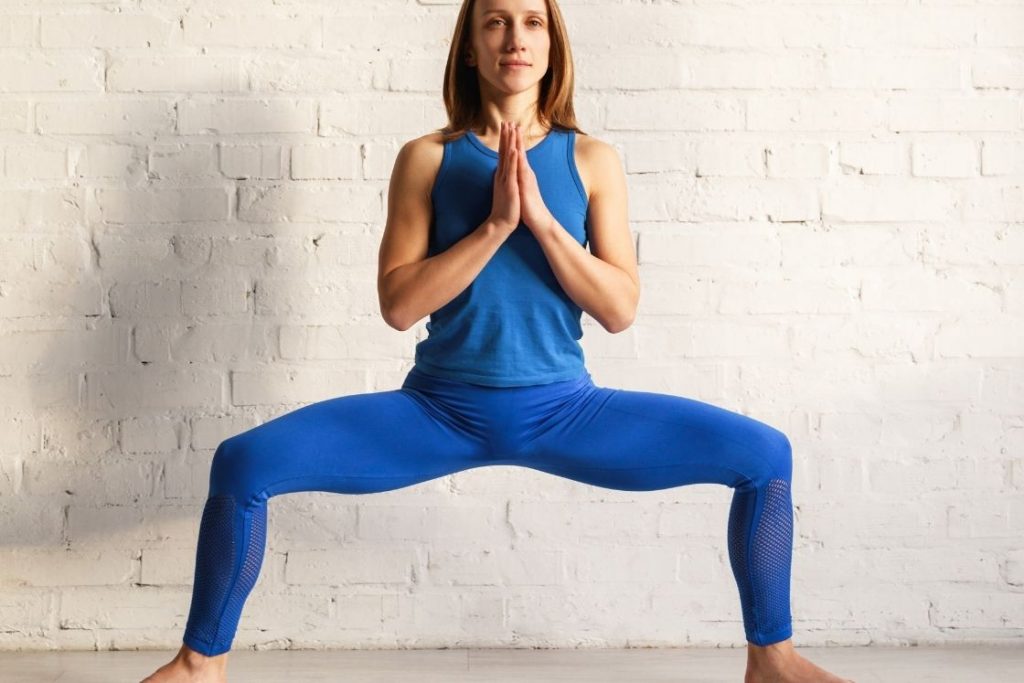
The Goddess Pose is a powerful yoga pose to promote grounding and strengthening of lower body parts. It is a hip-opening pose that will ignite a fire within that area.
While it builds your hip, legs, and glutes muscles, it is also a great chest opener and helps in spinal decompression. The pose is indeed a blend of stretch, strength, and mental toughness.
Goddess pose appearance is very simple and beginner-friendly, here you spread your feet apart and come into a wide-legged squat bending your knees at a 90-degree angle. Your thighs, hips, and groin area are strengthened through this stance.
A lot of hand variations can also be done in this pose, such as keeping them above your head, on your side with elbows bent and fingers spread, in front of your chest in prayer position, or on your thighs or hips.
Utkata Konasana Meaning
The Sanskrit name of goddess pose is Utkata Konasana where Utkata means fierce, Kon means angle and Asana means pose. Through this pose, you are invoking the powerful feminine energy inside you and making you more graceful and poised.
Goddess Pose represents the divine femininity of Hindu goddess Kali. The stance of this pose looks similar to the fierce form of the Kali that she takes to kill demons. She is often associated with shakti – feminine energy, creativity and fertility.
Through goddess pose, we get in touch with the divine feminine and balance our energy to feel the deep inner wisdom within ourselves.
This pose is extremely beneficial for pregnant females as it helps in widening and strengthening the pelvis, which will come in handy during childbirth. It is also an energizing pose that will stimulate the respiratory and cardiovascular systems.
Practice Guide for Goddess Pose
Follow these guidelines to perform this warm and energizing pose safely and correctly
Precautions and Contraindications
- Even though it is beneficial for pregnant women, goddess pose should be performed under guidance of registered prenatal teacher and should be avoided especially during the last trimester.
- You should avoid or practice under after consulting your doctor if you have recently undergone surgery or have an injury on your shoulder, ankle, hips, pelvis, knees, calves, hamstrings, or legs.
- This pose generates heat hence people with blood pressure history should perform it under supervision or for a shorter duration.
Preparatory Poses
Warm-up your lower body muscles with these poses before attempting the goddess pose;
- Mountain Pose (Tadasana)
- Garland Pose (Malasana)
- Standing Forward Fold Pose (Uttanasana)
- Chair Pose (Utkatasana)
How to Do the Goddess Pose(Steps)
- Stand in Tadasana (mountain pose) and then spread your legs in a wide stance. Your legs should be shoulder-width or 3 feet apart and toes should be turned 45-degree outwards.
- Bend your knees while exhaling and come to a squat. Your knees should be stacked on your ankles and thighs should be parallel to the ground. Draw in your navel and sink your hips with the help of your core muscles.
- Stretch your hands above your head and bend them at the elbows, palms facing outwards and fingers spread. The upper arm should be parallel to the thighs and elbows should make a 90-degree angle.
- Puff out your chest a bit and hold the pose for 5 deep breathes.
- To come out of this pose, straighten your legs and arms, bring your feet together and arms down and slowly come back to Tadasana (mountain pose)
Follow-up Poses
- All Warrior Poses (Virabhadrasana I, II, III)
- Bound Angle Pose (Baddha Konasana)
- Extended Side Angle Pose (Utthita Parsvakonasana)
Beginner’s tips
- Make sure your knees are over the toes and they are not bending too far off or else you’ll lose the balance.
- For a more advanced technique, you can bring your heels in line with the toes so that from one end of the foot to the other, it forms a straight line.
- Your spine should be straight. The shoulders should be in line with the hips and extend your tailbone downwards to keep the spine straight.
- Do not squat fully if you feel an uncomfortable burn. Only lower yourself to the point of your comfort level.
- The moment you feel tired, slowly come back to Tadasana and take a break for starting with the pose again.
Variations to the Goddess Pose
If you have issues with your shoulder, you can place your hands in front of your chest in the Anjali Mudra. Or you can keep your hands on your hips or thighs.
Some more hand variations that you can make in goddess pose are:
- Elbows bent at 90-degree and palms facing upwards tilted at 45-degree.
- Elbows bent to make a V shape and placing your fingers in the Gyan mudra.
- Stretch your hands overhead and joining your palms.
- Stretch your hands overhead and keep your palms facing each other.
For additional support and balance, hold the back of a chair or the wall to keep your back straight.
To make the pose harder, lift your heels and stand on the balls of the toes.
Modifications to the Goddess Pose
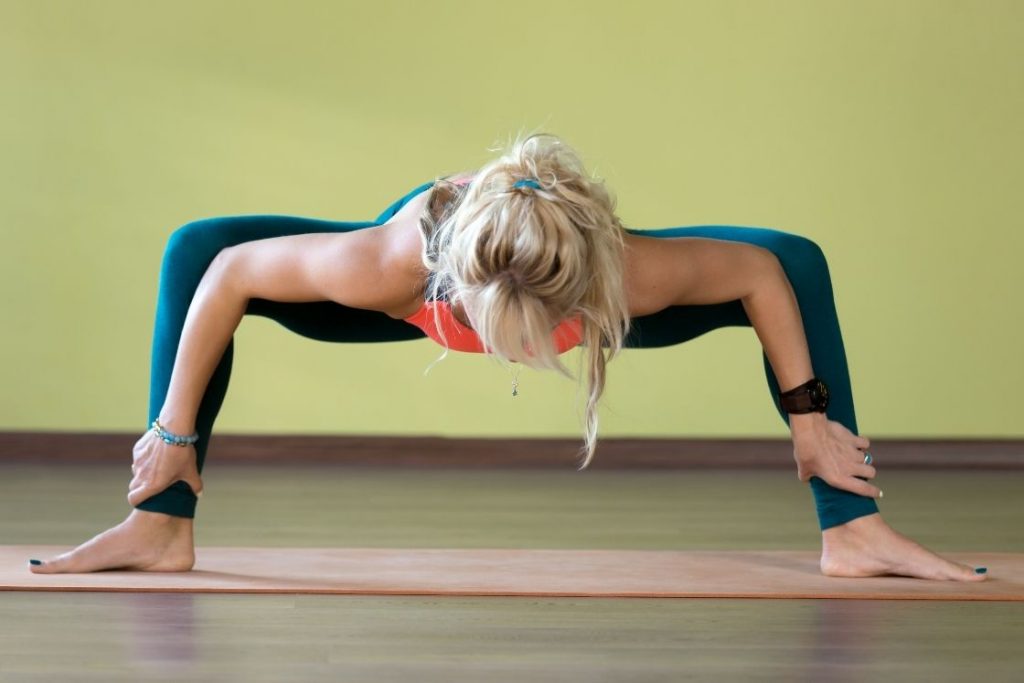
- Goddess Pose with a twist – While keeping you squat position, place your hands on the thighs and on a deep exhale from the belly, bring your left shoulder down into the center and look over your right shoulder. On inhale come back up and bring your right shoulder down in the center and look over the left shoulder on the next exhale.
- Goddess Pose swaying – This is more advanced level pose where you sway from side to side by puting weight on the right foot and then on the left.
- Goddess Pose push-ups – In this form, you do not have to go completely down. While in the wide-legged stance, go up by straightening your legs on an inhale and while exhaling come back to the squat position. You can repeat this for 5 breathes or until you start feeling a burn.
- Goddess Pose side stretch – While doing the twist, instead of keeping the hands on the thighs, you can bring your left palm to the ground and stretch the opposite hand over your head. Keep your gaze on the overhead stretched hands. Hold the pose for 5 breathes and repeat with teh other hand.
In another variation to this pose, place your left elbow on the left thigh and stretch your right arm above your head. Bend slightly towards the left to get a healthy stretch. - Goddess Pose forward bend – Bend forward while spreading your arms to the side like airplane wings or stretching your arms down and placing the palms on the ground. You can also hold your ankles while keeping your arms in the shape of your leg position or hold the opposite ankles with your hands.
Benefits of the Goddess Pose
- Widening pelvis for pregnant women – Due to the wide-legged squat, the goddess pose opens the pelvis region, which will be extremely beneficial at the time of childbirth. It also stimulates the reproductive organs by increasing the flow of prana energy to the area, thus improving fertility.
- Stimulates the chakras and kundalini energy – Goddess pose stimulates multiple chakras simultaneously such as Root Chakra (Muladhara), Sacral Chakra (Swadhisthana), and Solar Plexus Chakra (Manipura). The pose aids in better flow of prana energy through these chakras, helping remove blockages and activating them. The Kundalini energy, which resides at the base of the spine also gets activated through this pose, which further improves the energy distribution through all the chakras.
- Reduces tension and stress from the hip area – The squat stance of goddess pose opens and stretches various areas of the lower body such as hips, knees, ankles, and shoulders, with more emphasis on the hip. Most of the time, the hip area accumulates excess stress of the body and the Goddess Pose will help in removing the tension from that area. By holding the pose for a longer duration, you can de-stress the hip faster.
- Aids in Controlling Arthritis: Regular practice of this pose, which involves stretching various muscles and joints of the thighs, knees, and ankles, can help in managing arthritis.
- Shapes and Tones the Body: This pose helps in correcting posture by straightening and lengthening the spine, and building a stronger chest and shoulders. It also removes hunchbacks or stooping, contributing to a toned physique.
- Builds Awareness : Focusing on maintaining balance and breathwork during this pose helps in building awareness. This also aids in correcting limb alignment, ensuring the safe practice of the pose.
- Increases Internal Body Heat: Goddess Pose is a warm and energizing pose, making it beneficial for increasing internal body heat during winters.
- Grounding and Stability: The Goddess Pose is an excellent grounding pose, aiding in finding stability and balance for transitioning into more advanced poses.
- Tones the Upper and Lower Body: This pose helps in toning both the upper and lower body. Adding weights can further enhance these benefits.
- Connects to Sensual and Feminine Side: Practicing the Goddess Pose can help in connecting to your sensual and feminine side, enhancing your sense of bliss and sexual pleasure.
Conclusion
The Goddess Pose is a challenging, powerful, energizing, and stimulating standing pose that tones and strengthens the body. This pose can be performed by both men and women as each one of us has a feminine side that should be kept in balance, just like yin and yang. With multiple variations and modifications, this pose can help in stretching many muscles and joints to reduce tension and stress. It corrects your posture and also helps in building grace in your personality.
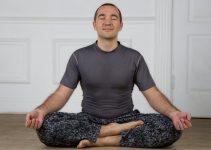
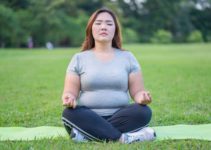
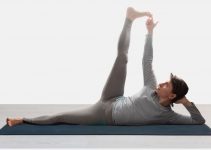


Pl guide whether Goddess pose activates Samana Vayu ?